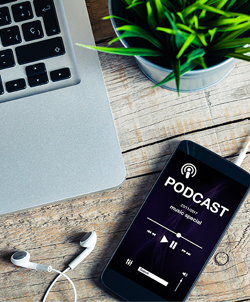

In the past year, as I walked my morning route, I joined the 44% (or 124 million) of our population listening to podcasts. Who are these listeners? Research by Edison Research in 2018 showed:
- Slightly more men (27%) than women (24%) listen.
- The largest group of listeners is 25–54 (32%), next is 12–24 (30%), and last is 55+ (13%).
- Active listeners average seven podcasts a week.
An article by FastCompany reports that as of April there were over 525,000 active podcast shows and over 18.5 million episodes.
Why Are They Listening?
The answer is mobility. 64% of podcasts are being listened to on smartphones or tablets. The audience listens at home, on their commute to work, while at work, on their evening walks, or while completing mundane tasks.
Who is My Audience?
When considering adding a podcast to your marketing plan, the first question to answer is “Who is my audience?” If your target audience is the 25–54 year-old group who want to control how, when, and where they get their information, then the podcast format is for them. If your goal is to bring in more senior executives, then you might be better off visiting their workplace and forget about the podcast.
Things to Consider for Your Podcast
Create great content. Clients are loyal to lawyers they trust, which is created by offering good, well-researched, and easy to understand information. Your podcast must convey the right image and interest your target audience. An interesting, informative, and entertaining message creates a great podcast.
Most popular podcasts have one thing in common—a consistent format. While there is no right way to conduct a podcast, it should be done the same way each time. For example, if you have an interview podcast, you might have a format as follows: Catchy introduction, main introduction, conversation, final questions, and windup.
Using the same format each session will encourage listeners to return and make producing and editing the show easier. If you don’t want to edit yourself, hire someone for you. Check local schools for sound engineering graduates or students to do the job for you.
Technical Considerations
Where to record is important for the quality of sound. Because most of you must record outside a sound studio, be aware of background noise, which can be distracting to your listeners. While you might be able to edit out those annoying sounds, it's better to prevent them first.
You will need microphones, microphone stands with pop filters, a digital audio recorder, and a computer with sound editing software for publishing. Buy the best equipment you can afford. Investing in good equipment will help achieve the sound quality your audience wants.
Getting Your Podcast Published
Sign up for a hosting site to post your final products. To be included on iTunes, sign up on iTunes Connect; for Google, look for Google Play. Once your podcast is published, iTunes and Google will ask you for the location link and then direct your listeners to it through their apps and websites.
Finally, a great podcast needs listeners. Announce it on your website, on social media, and on your SBM Member Directory profile. The value of your podcast will increase as it is included in your overall marketing plan.
 After years practicing law, Roberta Gubbins served as editor of the Ingham County Legal News. Since leaving the paper, she provides writing services to lawyers ghostwriting content for websites, blogs, and articles. She is editor of The Mentor, the SBM Master Lawyers Section newsletter.
After years practicing law, Roberta Gubbins served as editor of the Ingham County Legal News. Since leaving the paper, she provides writing services to lawyers ghostwriting content for websites, blogs, and articles. She is editor of The Mentor, the SBM Master Lawyers Section newsletter.
Read More Clear & Convincing Articles
Using the Enhanced Member Directory
How to Login and Edit Your Profile
CloudLawyers Directory Services
How to Contact CloudLawyers Support